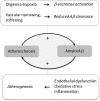Impaired Aβ clearance: a potential link between atherosclerosis and Alzheimer's disease
- PMID: 26136682
- PMCID: PMC4468824
- DOI: 10.3389/fnagi.2015.00115
Impaired Aβ clearance: a potential link between atherosclerosis and Alzheimer's disease
Abstract
Alzheimer's Disease (AD) and atherosclerosis remain two of the largest public health burdens in the world today. Although traditionally considered distinct pathological entities, mounting epidemiologic, clinical and experimental evidence suggests that cerebrovascular atherosclerosis and AD interact reciprocally to disrupt brain structure and function. Whereas the hypoperfusion and hypoxia caused by atherosclerosis of cerebral vessels may enhance the production of amyloid-β peptide (Aβ), a peptide central to AD pathology, Aβ, in turn, may promote formation of atherosclerotic lesions through vascular oxidative stress and endothelial dysfunction leading to additional vascular damage. Here, we briefly review evidence suggesting that impaired clearance of Aβ is an additional, simultaneously occurring mechanism by which AD and cerebrovascular disease may be causally linked. We examine the literature supporting mechanisms by which flow-limiting large-artery stenosis, arterial stiffening and microvascular dysfunction could contribute to AD pathophysiology by impairing Aβ clearance and elevating brain levels of Aβ. Finally, we highlight the need for further research to improve our understanding of the complex interactions of AD and atherosclerosis with Aβ clearance, which may ultimately serve to guide the development of novel diagnostic and therapeutic approaches for this devastating and highly prevalent condition.
Keywords: A beta clearance; A beta peptide; Alzheimer’s disease (AD); atherosclerosis; dementia; vascular.
Figures

References
Publication types
Grants and funding
LinkOut - more resources
Full Text Sources
Other Literature Sources

